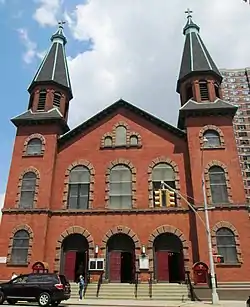St. Mary Church (Grand Street, Manhattan)
| St. Mary's Church | |
|---|---|
 (2013) | |
| General information | |
| Town or city | Manhattan, New York City |
| Country | United States |
| Construction started | 1832 |
| Completed | 1833 (original church) 1864 (enlarged with new facade)[1] 1871 (additional changes)[2] |
| Client | Roman Catholic Archdiocese of New York |
| Design and construction | |
| Architect(s) | Patrick C. Keely (facade)[3] |
| Website | |
| https://saintmarygrand.org | |
The Church of St. Mary is a Roman Catholic parish church in the Roman Catholic Archdiocese of New York, located at 438–440 Grand Street between Pitt and Attorney Streets in the Lower East Side neighborhood of Manhattan, New York City.[4] Established in 1826 to serve Irish immigrants living in the neighborhood, it is the third oldest Catholic parish in New York.[2] The church itself was built in 1832–33, and was then enlarged and had its facade replaced in 1871 by the prolific church architect Patrick Charles Keely. The original portion is the second oldest Roman Catholic structure in the city, after St. Patrick's Old Cathedral, which was built in 1815.[3]
History
Before their sanctuary was built, services were held in a former Presbyterian church on Sheriff Street. Rev. Hatton Walsh was named pastor. In 1831, anti-Catholic nativists set fire to the church, but it was not completely destroyed and continued to operate. The first New York chapter of the Ancient Order of Hibernians was established in 1836 at nearby St. James Church partly in response.[2]
In 1832 the cornerstone was laid for the present building, which was dedicated in June 1833. Rev. William J. Quarter, curate at St. Peter's on Barclay Street, was named pastor. Quarter would later become the first bishop of Chicago.[5]
Originally designed in the Greek Revival style, the new red brick facade designed by Patrick Charles Keely in 1864 was in the Romanesque style and featured twin spires. Other changes were made by Lawrence O'Connor in 1871.[2]
The Irish-American prelate, Rev. Michael McKenna, who had ties to Irish nationalist movement, was assistant pastor here in 1868 before becoming the first pastor of the newly separated – from St. Mary's parish – parish of St. Rose of Lima.[6] Charles Edward McDonnell, future Bishop of Brooklyn, was assigned as curate here in the autumn of 1878.
References
Notes
- Remigius Lafort, S.T.D., Censor, The Catholic Church in the United States of America: Undertaken to Celebrate the Golden Jubilee of His Holiness, Pope Pius X. Volume 3: The Province of Baltimore and the Province of New York, Section 1: Comprising the Archdiocese of New York and the Diocese of Brooklyn, Buffalo and Ogdensburg.... (New York City: The Catholic Editing Company, 1914), p.345-347.
- American Guild of Organists; New York City chapter, Church of St. Mary (Roman Catholic)
- White, Norval; Willensky, Elliot; Leadon, Fran (2010). AIA Guide to New York City (5th ed.). New York: Oxford University Press. ISBN 978-0-19538-386-7. p.106
- The World Almanac 1892 and Book of Facts (New York: Press Publishing, 1892), p.390.
- Wilson, James Grant and John Fiske. "William Quarter". Appleton's Cyclopedia of American Biography.
- Remigius Lafort, S.T.D., Censor, The Catholic Church in the United States of America: Undertaken to Celebrate the Golden Jubilee of His Holiness, Pope Pius X. Volume 3: The Province of Baltimore and the Province of New York, Section 1: Comprising the Archdiocese of New York and the Diocese of Brooklyn, Buffalo and Ogdensburg Together with some Supplementary Articles on Religious Communities of Women.. (New York City: The Catholic Editing Company, 1914), p.369.
